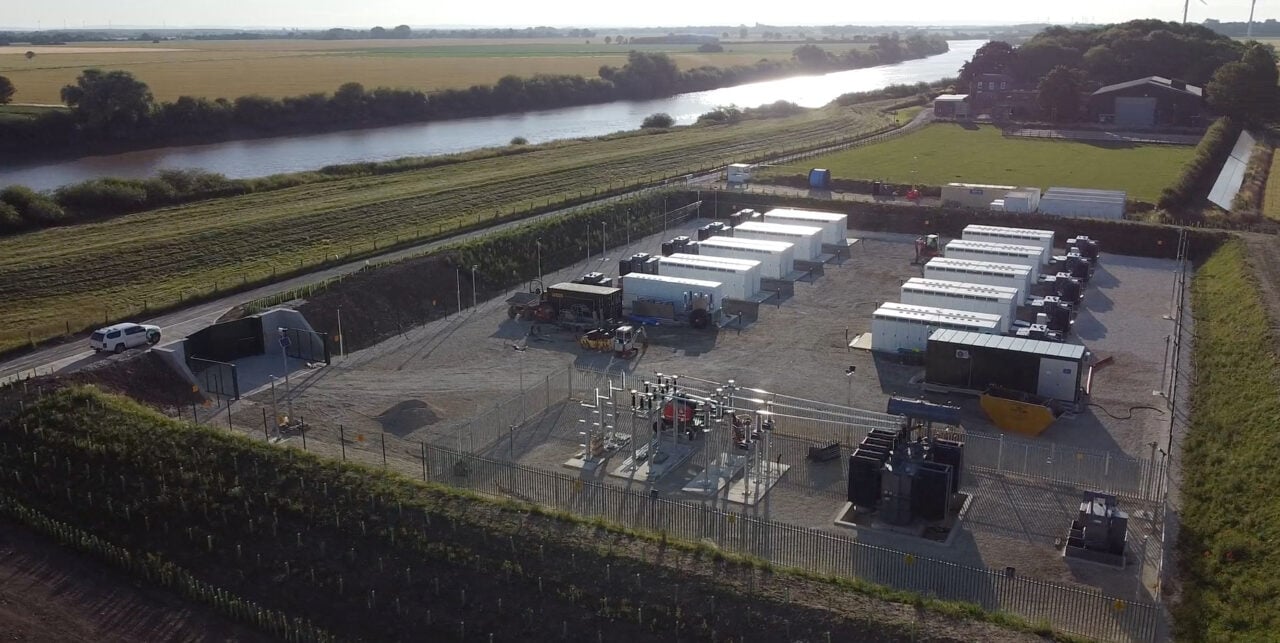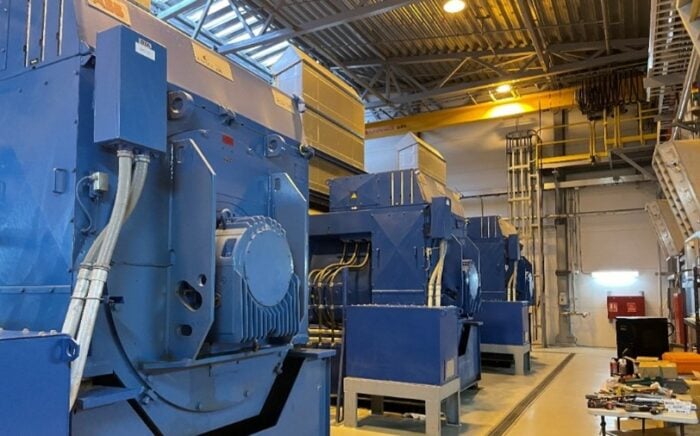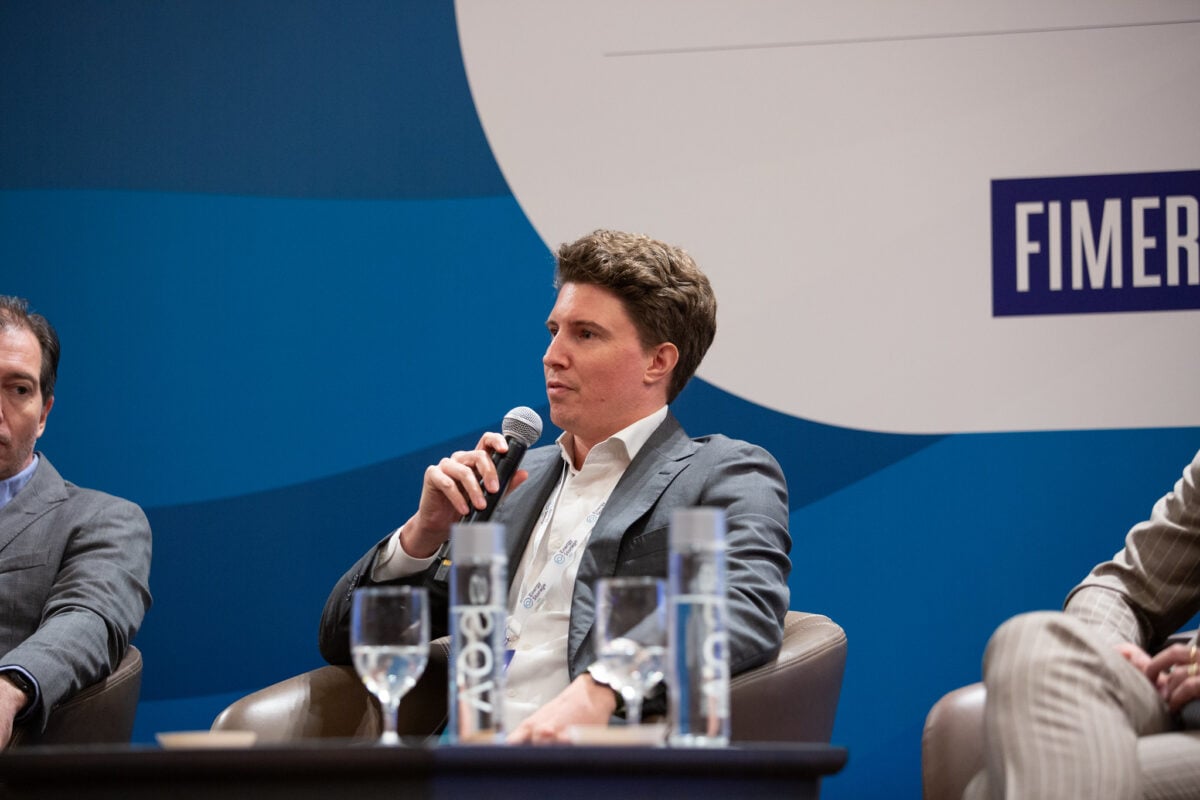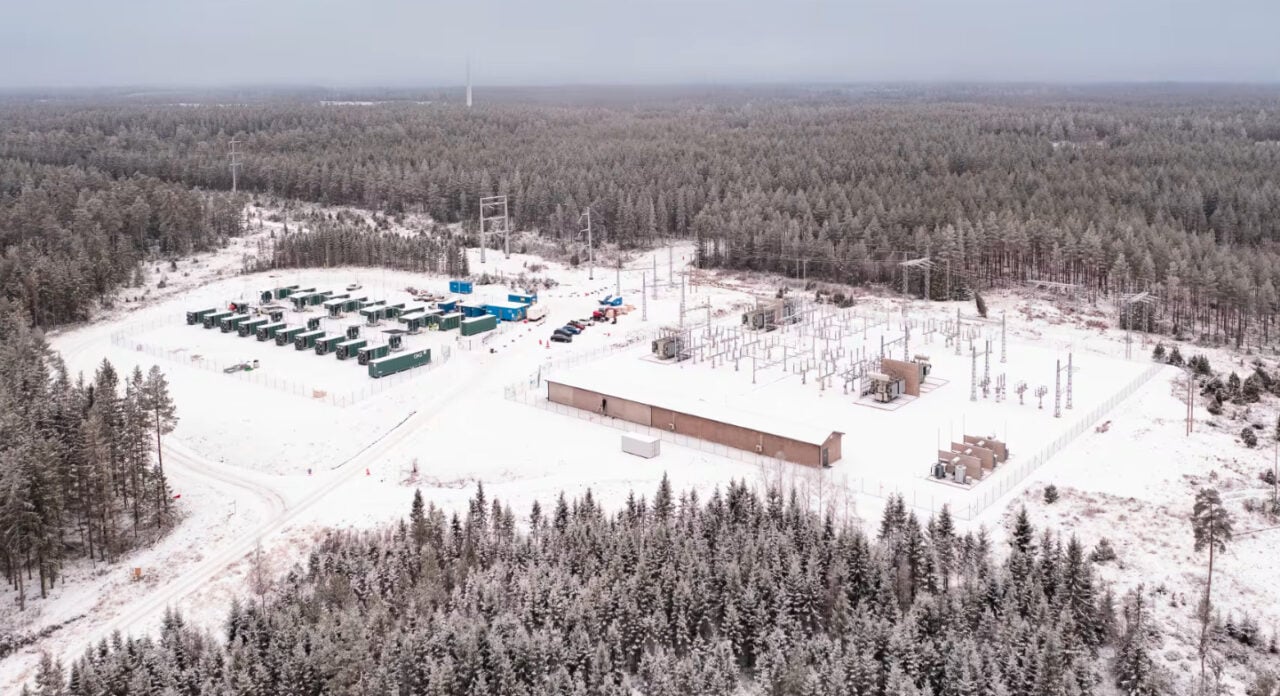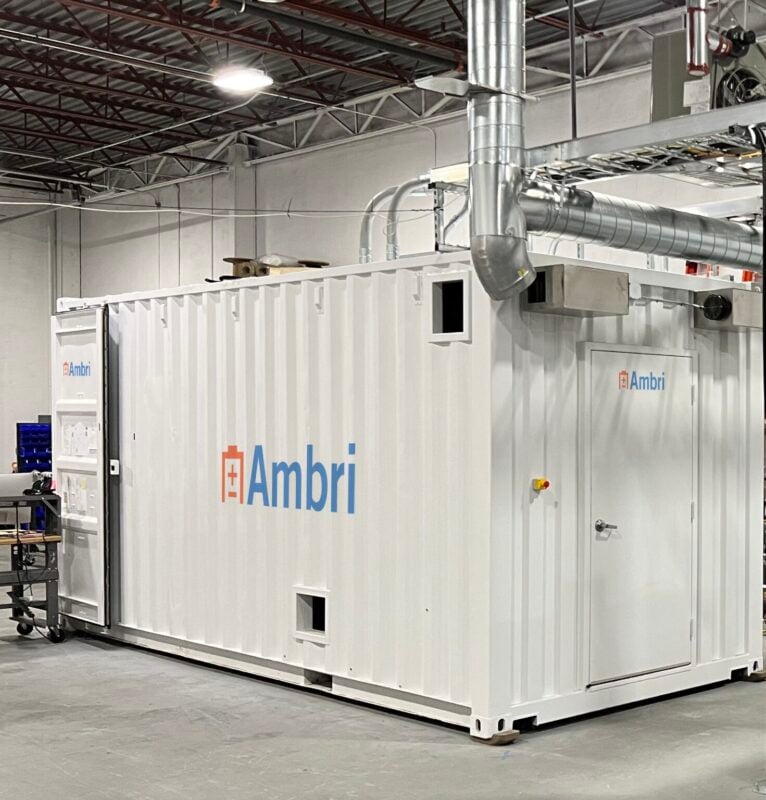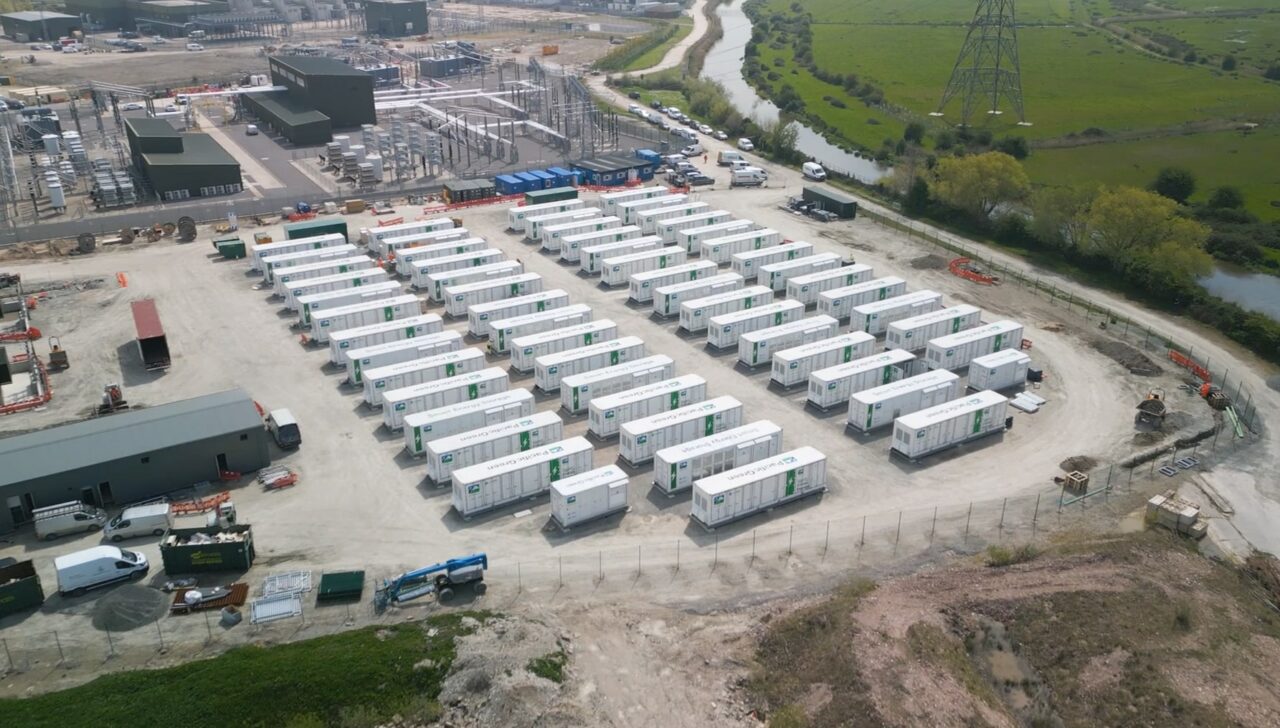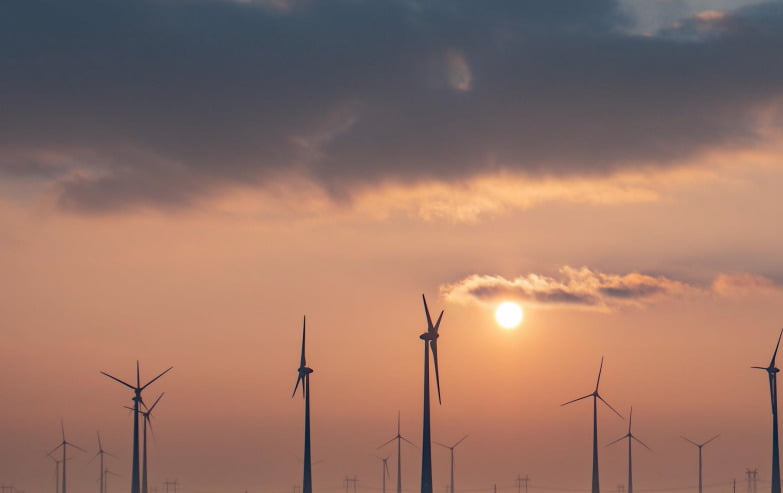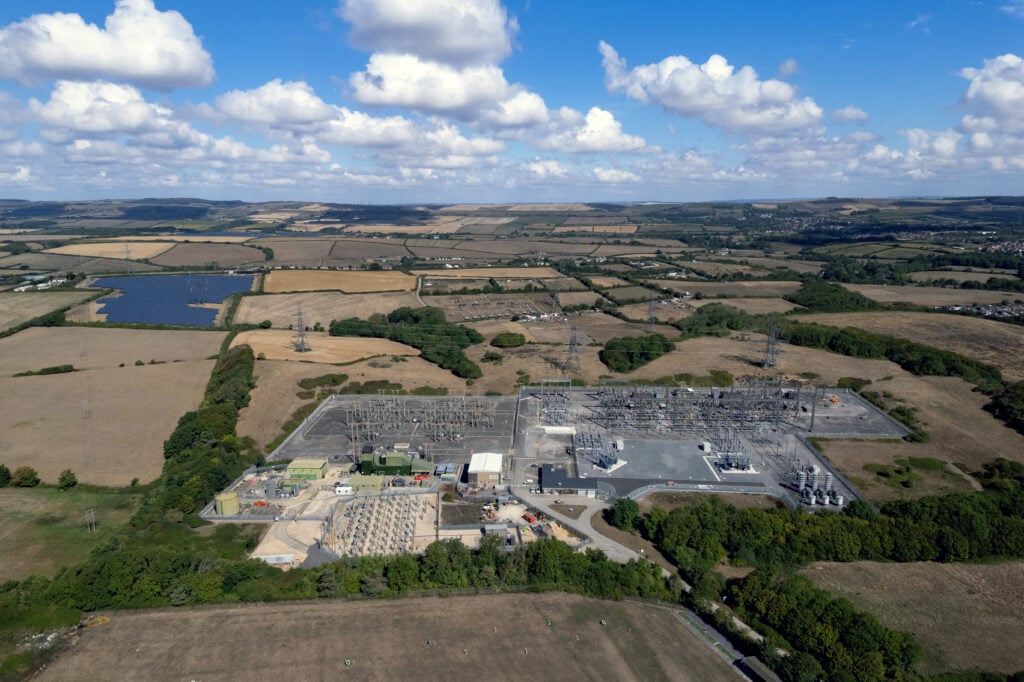Developed by Harmony Energy, the project’s construction was managed by Tesla with oversight by the Harmony Energy project team. The battery energy storage system (BESS) will be located in Rusholme and is expected to be fully operational in all markets in early August.
Harmony Energy is a developer and investment advisor to the Harmony Energy Income Trust fund.
The BESS will operate through Tesla’s algorithmic trading platform, Autobidder, which has already been deployed at other Harmony projects.
To see the full, original version of this article go to Solar Power Portal.
Envision Energy to supply BESS for 50MWh Field project
Envision Energy has partnered with renewable energy infrastructure firm Field to develop a 50MWh battery energy storage system (BESS) in Blackburn, England.
Envision Energy will supply the Field Whitebirk project with the necessary hardware and equipment to install the BESS onsite. The agreement is part of a long-term partnership aimed at helping Envision’s energy storage division in the UK and Europe.
Mark Walton-Hayfield, senior director for energy storage in the UK and Ireland at Envision Energy, said: “We are proud that our advanced BESS solutions have been recognised by Field for their exceptional standards in safety, reliability and technical capability. We are excited to bring our Tier 1 technology to Whitebirk whilst continuing to collaborate and partner with Field more broadly and make a significant contribution to the global energy transition.”
To see the full, original version of this article go to Solar Power Portal.
Construction starts on E.ON and Quinbrook’s 460MWh BESS
Construction is underway on a new battery energy storage system (BESS) project, set to be one of the UK’s largest.
The project, located on the site of a former coal-fired power station in Uskmouth, South Wales, is a collaboration between major international energy firm E.ON and global investment manager Quinbrook Infrastructure Partners.
Building work is being undertaken by local firm Jones Bros Civil Engineering UK, which states that activity is currently focused on developing the foundations for the battery and the power conversion systems (PCS) units, as well as the primary and secondary substations and transformers.
Part of the development plan involves significant ecological enhancement, including the development of a new sustainable energy park and landscaping work to make the area more appealing to wildlife, including otters and water voles.
Construction is expected to be completed by the first quarter of 2025.
To see the full, original version of this article go to Solar Power Portal.
Planning permission for 23MW solar project with 57MW battery storage facility
The minister of state, Matthew Pennycook, has granted planning permission for a 23MW solar development with 57MW of battery storage to be installed in Warwickshire.
Set to be operational for 40 years, a revised application was submitted for the solar and storage project by Enso Green Holdings in October 2022. Enso Energy is a renewable energy developer that recently co-developed the first solar and storage project to be connected at a transmission level.
Pennycook, the minister who approved the plans on behalf of the secretary of state, has been vocal in his support of solar development in the UK.
The Warwickshire project, Honiley Road Solar Farm, had been approved by the Warwickshire District Council planning committee in July 2023 but was ‘called in’ by the then-secretary of state for the Department for Levelling Up, Housing and Communities in February this year.
To see the full, original version of this article go to Solar Power Portal.
Government fast track towards construction for two pumped hydro projects in India
This, the authority said, is in order to enable their commissioning “on a fast track”. The announcement comes shortly after the government’s finance minister Nirmala Sitharaman pledged in the Union Budget 2024 that PHES plants would be supported by policy measures.
The CEA advises the Indian government on policy and formulates electricity system plans. As regular readers of Energy-Storage.news may have seen, its National Electricity Plan 2023 which helps guide the Ministry of Power called for large deployments of both battery energy storage system (BESS) and PHES-based energy storage in the coming years.
As India targets 500GW of new non-fossil fuel energy by 2030, and net zero emissions from all sectors of the economy by 2070, the integration of storage into the power system will become increasingly vital, the CEA and government have projected.
By the 2031-2032 timeframe, that equates to about 47GW/236GWh of grid-connected batteries, and 27GW/175GWh of pumped hydro, for a total 74GW energy storage output and 411GWh capacity.
By 2047, CEA modelled that a total of 320GW/2,380GWh will be needed, with 230GW/1,840GWh from battery storage and 90GW/540GWh from PHES.
176GW of pumped hydro potential across India
CEA said that it has so far received around 60GW of proposals for PHES projects, currently at the Survey & Investigation stage, ahead of detailed project reports (DRPs) being put together.
The two projects selected last week are the 600MW Upper Indravati PHES in Odisha, being developed by Odisha Hydro Power Corporation (OHPC), and the 2000MW Sharavathy project in Karnataka, in development through Karnataka Power Corporation Ltd (KPCL).
Upper Indravati would see pumped hydro capacity added to an existing 600MW (4 x 150MW unit) hydroelectric power plant. According to OHPC’s website, the corporation also wants to add pumped hydro to two other operational hydro plants, the 320MW Upper Kolab plant and 510MW Balimela plant.
Sharavathy meanwhile appears to be a 2,000MW PHES addition to an existing 1,035MW pumped hydro plant in Karnataka.
In addition to fast-tracking the two plants towards DRP status, the CEA has revised its guidelines for submitting projects into planning, which again is aimed at streamlining and speeding up the process.
CEA noted that in addition to the 60GW of submitted proposals, India currently has 4.7GW of PHES plants in operation, 4GW already under construction and 3.6GW have ‘concurred,’ meaning construction is to be started. India’s total PHES, or pumped storage plant (PSP) potential, to use CEA’s own terminology, is about 176GW, the authority said.
See more of Energy-Storage.news’ coverage of the energy storage sector in India, including recent tenders for standalone energy storage, renewables-plus-storage and Firm Dispatchable Renewable Energy FDRE.
Belize and US Virgin Islands progress large-scale BESS projects
The Ministry of Finance, Economic Development and Investment is seeking expressions of interest (EOI) from consultants and experts to assist it with the Belize Renewable Integration and Resilient Energy System Project, using World Bank funding.
Interested consultants have until 2pm local time on 8 August—this coming Thursday—to provide information demonstrating their suitability to provide goods, consulting and non-consulting services for the project.
Contact details for the EOI process can be found here.
The Belize Renewable Integration and Resilient Energy System Project is aimed at improving the resilience of the electricity system against extreme climates by strengthening the national transmission infrastructure.
It will fund the acquisition and deployment of BESS to enable the integration of renewable energy onto the grid, and improve resiliency and reliability of electrical supply. A total of US$65 million will be invested in the project, according to the World Bank.
The project’s primary implementing agency is Belize Electricity Limited, the country’s main utility and network operator.
It comes shortly after nearby Honduras progressed the reform of its electricity market to enable the deployment of energy storage at scale on its grid.
Wärtsilä completes generators-plus-BESS on US Virgin Islands
In concurrent news, the publicly-owned utility for the US Virgin Islands has announced the completion of a new BESS alongside upgrades to an existing gas power plant, the Randolph Harley Power Plant (RHPP).
The Virgin Islands Water and Power Authority (WAPA) announced the completion last month (24 July) after which it began final commissioning of the generators and BESS equipment.
As Energy-Storage.news reported when the project neared completion last year, system integrator Wärtsilä provided a hybrid solution combining four 9MW fossil fuel engines together with a 9MW, 2-hour duration (18MWh) BESS unit. The company got the contract for the job in 2020, which was delayed due to Covid-19.
The fossil fuel engines totalling 32MW of power run on liquid petroleum gas (LPG) and light fuel oil (LFO).
Finland-headquartered Wärtsilä is active in supplying island power solutions, also providing a 25MW/25MWh BESS on another Carribean island, Curaçao.
Earlier this year, the Comisión Nacional De Energia of the Dominican Republic started construction on a 99MWh BESS in the country.
Eku Energy finances battery storage project in Japan with ‘first-of-a-kind’ tolling deal
“There are certain major milestones to hit until a utility scale battery energy storage system is ready to support the grid and be a major contributor to the #energytransition. Financial close is certainly one of those,” the developer posted.
As reported by Energy-Storage.news in April, the company’s Hirohara BESS project will be a 30MW/120MWh (4-hour duration) asset in Oazu Hirohara, a region of Miyazaki Prefecture on the southern Japanese island of Kyushu.
It appears this site jumped the gun a little in reporting that previous announcement, assuming that financial close had already been achieved at that time, but as the post on Friday clarified, that is now the case.
Eku Energy said the financial close is a ‘major milestone’ in preparing a BESS project to contribute to balancing the grid, and that the latest development showed the developer is ‘on track to hit all future milestones as planned’.
Offtake deal with Tokyo Gas
Perhaps most notable about the project is the claimed “first-of-a-kind” offtake deal within the Japanese market that Eku Energy has signed for it, with utility company Tokyo Gas.
Tokyo Gas has contracted for full operating rights over a 20-year term to the Hirohara BESS, which Eku Energy will own. In April, the utility said in a Japanese-language press release that the project marked its first steps towards full-scale entry into the grid battery storage business.
Tokyo Gas would use its experience in energy trading markets to use battery storage to contribute to stabilising the grid and enabling greater integration of renewable energy.
At the same time, Tokyo Gas will also leverage the control capabilities of behind-the-meter (BTM) battery storage systems installed at customer premises, which could include commercial and industrial (C&I) facilities.
It is also a first in Japan—although not a first BESS project internationally—that Japanese bank MUFG has participated in project financing for. The bank is becoming somewhat prolific in the sector, particularly in the US, where last week Energy-Storage.news reported its involvement in a US$515 million finance raise by developer Eolian, and US$258 million secured by esVolta.
Eku Energy also said in its LinkedIn announcement that construction partners on the Hirohara BESS include integrated systems engineers Kinden Corporation, renewables specialist Looop and Fortec Architects, all Japan-headquartered companies.
‘Multiple commercialisation pathways’ for BESS in Japan
At the Energy Storage Summit Asia 2024, held last month in Singapore and hosted by our publisher Solar Media, Eku Energy’s APAC technical lead Nick Morley said that having started his career in clean energy working at a solar panel testing facility in Yokohama, Japan, he was “very excited to be working on a BESS project in Japan now”.
Eku Energy has only been around in its present form for about a year-and-a-half and has projects under construction or in development in Australia, the UK and Italy.
Japan’s BESS market is in its relative infancy, and a lot of interest has been created recently by the Long Term Decarbonization Auction (LTDA), a new capacity market opportunity through which batteries and pumped hydro energy storage (PHES) projects were awarded a combined 1.67GW of 20-year contracts.
However, speaking in a panel discussion on Japan at the Asia Summit, Eku’s Nick Morley said that developer “knows for sure that the LTDA is not the only way to commercialise projects in Japan”.
Morley said Eku believed its Tokyo Gas deal to be the first of its kind in the market.
“One of the things that’s attractive about Japan is that there are multiple commercialisation pathways there. It’s not completely dependent on the LTDA,” Morley said.
Yet, it is still early days for many of those pathways and Morley added that mechanisms like the LTDA coming from the policy space, as well as those “multiple commercialisation pathways” would both be beneficial in making Japan an attractive market for investment.
Fellow panellist Ross Bennett of German state-owned bank NORD/LB said that the LTDA is not the only way to finance a project or “the only way to obtain debt finance on a project” in Japan.
“We are also seeing other markets in long-term corporate offtake solutions. In Japan, there are several very large and strong credit-worthy players,” Bennett said.
Meanwhile, Bennett said, different types of contracts and financing which could include different blends of long-term contracts either with corporate offtakers or underwritten by government schemes, along with merchant revenues, will likely take some time to evolve in Japan, as has been seen in other markets. Once that takes off, it could happen quite quickly Bennett said.
Morley said that if the diversity of commercialisation strategies in the country increases, lenders can also become more comfortable with a degree of merchant risk exposure.
For Eku Energy, and perhaps others, like Pacifico Energy, which delivered Japan’s first two BESS projects trading in the wholesale power market, there could be an advantage in being early in entering the market.
“There is a kind of incentive for greater risk-taking behaviour from developers in the storage business. In many markets, time and again, we see that there is a major first-mover advantage,” Morley said.
Energy-Storage.news Premium subscribers can read the write-up of the Japan panel discussion from the Energy Storage Summit Asia 2024. For more information on next year’s Asia event, see the official website: ESN Premium subscribers can enjoy special discounts on tickets.
OX2 sells 110MWh Finland BESS to L&G NTR fund
The Uusnivala project is just shy of being largest BESS project being built currently in the Nordic country, which at present would be a 56.4MW/112.9MWh system from IPP Neoen (Premium access article). OX2 didn’t reveal when the project is expected to come online.
The BESS will participate in Finland’s ancillary service and wholesale energy markets, being located near an interconnection point with a high penetration of wind energy. The market is still predominantly ancillary services, as most wind-dominated renewables markets are, but projects have started to move to 2-hour durations recently.
Around 300MW of grid-scale BESS is expected to come online in Finland over the next two years according to research firm LCP-Delta.
It is OX2’s first sold BESS project in Finland, and comes shortly after it sold its first BESS project anywhere, in Sweden, earlier this year. The company is primarily active in wind and solar but is expanding into BESS, and an executive discussed its approach to the new sector in an interview with us last year (Premium access).
L&G is a UK-based investor and asset manager which has not yet moved into renewables at scale yet, while NTR is a Ireland-based renewables developer and infrastructure investor. Go to our sister site Solar Power Portal for coverage of NTR’s activity.
Liquid metal startup Ambri back in business after Chapter 11 bankruptcy
Ambri had entered Chapter 11 bankruptcy protection with the US Bankruptcy Court for the District of Delaware in early May. It said at the time that an agreement for lenders to buy up assets was already in place.
The company, founded by MIT professor Donald Sadoway in 2010, makes high-temperature batteries based around liquid calcium anodes and molten salt electrolyte, while the cathode materials contain solid antimony particles.
Ambri has claimed that its raw materials are abundant and low-cost, while the technology is suitable for providing long-duration energy storage (LDES).
It has been able to attract some big name backers to date, including Microsoft founder Bill Gates’ Gates Frontier venture capital (VC) fund, and India’s Reliance Industries. A pilot deployment at a Microsoft data centre was commissioned in 2022, and in the same year, a pilot project with Reliance was announced.
Other key developments for the company included plans for a pilot project with utility Xcel Energy in Colorado, US, of which details were provided around a year ago and on which construction was expected to begin this year.
Ambri’s systems received UL1973 certification in 2022 and the company signed a deal in Q3 2021 for 13GWh of key materials supply with an investor in a successfully closed US$144 million funding round.
The company said this week that a competitive sale process was conducted in accordance with Section 363 of the Bankruptcy Code, after its board decided that the sale would be the best avenue to recapitalise the company and secure its future.
Sadoway’s co-founder and co-inventor of the proprietary liquid metal battery, Dr David Bradwell, will assume the position of CEO, having been CTO since Ambri was launched, while Prof Sadoway remains Chief Scientific Advisor.
“The team at Ambri has continued to make impressive progress towards a commercial long-duration battery system, including developing our third-generation cell product. We look forward to offering our unique, safe, and low-cost commercial product to our customers at scale, to meet the strong customer demand for our battery systems, and for a cleaner energy future,” new CEO Bradwell said.
“As we embark on this fresh start with a stronger balance sheet and new capital, we are focused on positioning Ambri to play a leading role in the long duration energy storage market for the benefit of our stakeholders.”
Will degraded batteries be a resource or liability? Industry hedging bets on BESS end-of-life question
However, right now the statutory rules in the UK which designate responsibility for disposing, recycling or re-using end-of-life batteries is largely irrelevant for the grid-scale BESS market. This is because the responsibility elapses one year after the batteries are placed into the market, law firm Freeths’ construction and engineering partner Suriya Edwards said, and no project is decommissioned after a year.
However, contractual parties in BESS projects are still having to think about the topic and even including contractual language around the end-of-life, but who the responsibility falls on is an open question, to be decided between those parties.
Lithium-ion batteries contain precious metals like lithium and sometimes nickel and cobalt, meaning potential value to be extracted after their use in BESS – especially considering the Batteries Regulations’ minimum recycled content thresholds.
“How that longevity piece is going to fit into your commercial model is something to think about,” Edwards said.
Level of end-of-life focus depends on contract type
Edwards said that grid-scale BESS in the UK are procured either via a single contract between a developer and engineering, procurement and construction (EPC), known as ‘full wrap’, or via multiple contracts for EPC and battery procurements separately, sometimes with a system integrator sitting in between.
The real thought is given to end-of-life solutions for BESS in the battery procurement contracts: between EPC and BESS supplier in the first example, or between system integrator or developer and BESS supplier in the latter.
But parties are not committing to specific agreements, but typically laying out the different options in writing, Edwards explained, keeping their options open for whether the batteries will be a liability or a resource.
Contracts include provisions for either scenario
“An EPC firm will typically tell its battery supplier ‘we will require it to eventually take the batteries back at your own cost’, but if later it proves to be a liability then it might offer to pay the supplier money to take those batteries away. Essentially, they are still determining if it’s going to be an asset or something that will cost money to recycle and dispose of,” Edwards said.
“Similarly, a battery manufacturer selling batteries will say ‘my contract does not include the price of taking the batteries back, and we will want money to do it’. But it will also include a provision that works out a way of you getting some money back from them if they decide it’s a resource they are keen to get back.”
Some contracts however make no mention of end-of-life BESS solutions at all. “It’s not a mainstream discussion, but the battery procurement contracts are the ones with the most advanced understanding of how risk is apportioned,” Edwards added.
It may however be a larger topic of discussion between battery manufacturers, BESS manufacturers and system integrators, for whom the battery technology is a key part of their long-term business model, but Freeths primarily works with developers and asset owners. More recently, the firm has been working with some mainstream BESS manufacturers.
The ambiguity over whether lithium-ion batteries will be a resource or a liability is unsurprising considering how quickly the technology moves and how fast prices have dropped (bar the blip in 2022).
Battery recycling companies even today tell Energy-Storage.news that whether they have to pay for batteries or are paid for batteries to recycle depends hugely on the type and quality of the battery, and battery pricing trends also likely play a role even today.
The related topics of insolvencies and ESG in contracts are also really important, Edwards said, and there are big questions around how to deliver these into procurement contracts.
Bigger players more ready for this than smaller ones
“The big guys are clearly on top of it and are looking at the Battery Passport, and speeding ahead with the supply chain focus and the due diligence focus around the end-of-life topic, but the smaller companies have potentially no clue that this will hit them,” Edwards said.
“I would say the smaller battery companies coming in from the Far East will need to quickly upscale themselves in order to work out the whole question of producer responsibility.”
UK likely to follow EU’s Batteries Regulation
Edwards and her colleague Kirstin Roberts (waste and renewables specialist), speaking on a recent webinar hosted by Freeths on the topic, both said that the UK is likely to follow in the EU’s footsteps and update its battery rules to something similar to the bloc’s Batteries Regulation.
The key pieces of the Batteries Regulation are minimum levels of recycled content for batteries as well as the Battery Passport, a digital register of every single battery made using a QR code, which will contain the necessary information to make reusing or recycling batteries easier.
“The UK is likely to follow up with something similar, it’s not certain but it’s more than a hunch. We are in an exceptionally globalised industry and the supply chains extend well into the Far East and China.”
“I would be very surprised if we did not have a consistent approach which mirrors the EU in this respect, both in terms of perhaps even establishing our own in-house internal industry to recycle or working cross-border with the rest of Europe on it. And if you look at all the different reporting and disclosures standards coming into the UK it will be useful to have a mechanism that records that stuff for batteries, like the EU’s Regulation does.”
Eolian, BrightNight and esVolta raise more than a billion dollars from financiers
The total US$390 million financing builds on a previous US$515 million green loan transaction the developer made in mid-2023 with the same six banks: Spain’s Santander, Japan’s MUFG and SMBC, National Australia Bank, Natixis (France) and Lloyds Bank (UK).
Eolian invests in energy storage and renewable energy projects, although its focus to date has largely been on battery energy storage system (BESS) assets in the US, with projects such as the 100MW Chisholm Grid and 200MW Madeiro and Ignacio Grid in Texas developed by Eolian’s wholly owned energy storage power producer subsidiary Astral Electricity.
The loan was secured under Green Loan Principles against a group of Eolian projects, of which further details were not given in a press release. Other financial backing the company has received to date includes US$925 million in early 2022, again by a consortium that included banks Santander and MUFG.
In early 2023, Eolian made headlines as it claimed to be the first to complete an investment using the investment tax credit (ITC) for standalone energy storage brought into the US market by the Inflation Reduction Act (IRA). This was for its twin Madeiro and Ignacio BESS assets.
esVolta raises financing for 980MWh ERCOT portfolio
esVolta, a pure-play developer, owner and operator of utility-scale energy storage projects, also announced its financing on Tuesday this week.
The company has closed senior secured credit facilities worth US$258 million for a portfolio of standalone BESS projects in Texas, totalling 980MWh of capacity.
MUFG was again involved, as Coordinating Lead Arranger and Green Loan Coordinator. Fellow Japanese finance group Nomura Securities was also a Coordinating Lead Arranger, as was US investment bank KeyBanc Capital Markets. Also involved were Joint Lead Arranger Investec while Cadence Bank also participated.
The credit facility comprises construction and tax equity bridge financing, letters of credit and a long-term loan for three esVolta projects: its 240MW/480MWh Anole project in Seagoville, the 150MW/300MWh Desert Willow project in Midlothian, and Burksol, which is in Dickens County and will be 100MW/200MWh.
According to esVolta’s website, the developer has hedge contracts in place for each of the three projects, although it has kept customer names confidential. Each will be in the ERCOT market which spans most of Texas’ electricity networks.
Most of esVolta’s existing operational projects are in the California market, although it has projects in development, construction or operation in other US states, including Arizona, Virginia, Washington and New Mexico, as well as Texas. The company, founded in 2017, was acquired by sustainability investor Generate Capital in 2022.
Goldman Sachs Alternatives backs hybrid IPP BrightNight
BrightNight, an independent power producer (IPP) specialising in hybrid solar PV, wind and battery storage projects, has secured a US$440 million strategic investment from Goldman Sachs Alternatives.
The financing was announced today, with the transaction expected to close in September.
Goldman Sachs Alternatives is the alternative investment platform of Goldman Sachs Asset Management. It is claimed to have invested around US$16 billion in infrastructure projects since its establishment in 2006.
BrightNight markets its hybrid power plants to utilities and commercial and industrial (C&I) entities seeking firm dispatchable renewable energy resources as well as large landowners looking to put renewable power projects on their real estate.
It has developed its own AI-driven proprietary software, called Power Alpha, which the company uses to ‘optimise the design, development and operation’ of its renewable power plants.
The company is active in the US, India and Australia, and while it appears to be yet to bring any projects into commercial operation from a claimed 31GW global development pipeline, it recently secured grid connection approval for a large-scale solar-plus-storage project in Victoria, Australia, and a US$414 million construction credit facility for Box Canyon, a 300MW solar PV plant in Arizona, US.
Box Canyon will also feature a 600MWh BESS, and Brightnight signed a power purchase agreement (PPA) offtake contract for the project’s output in 2022 with Southwest Public Power Agency (SPPA), representing a group of Arizona municipal utilities and local authorities.
Energy-Storage.news’ publisher Solar Media will host the 1st Battery Asset Management Summit USA in San Diego on 12-13 November 2024. Featuring a packed programme of panels, presentations and fireside chats from industry leaders focusing on Connecting Asset Owners and Optimizers to Maximize Strategies for Storage Assets. View the website today
Ark Energy developing 2.2GWh, 8-hour co-located BESS in Australia
Ark Energy, a subsidiary of Korea Zinc Co, a zinc smelter, confirmed that the BESS would use lithium-iron phosphate (LFP) technology and be eight hours in duration.
On the solar aspect of the project, either crystalline silicon or thin-film technology would be used, mounted on an east-west tracking system. It will consist of up to 730,000 bifacial solar modules.
See the full original version of this article on PV Tech.
Statera gets planning consent for 6-hour, 2.4GWh UK BESS project with BYD batteries
Energy-Storage.news is expecting comment from Statera and will update this article in due course.
The project had been controversial amongst locals for its size and the fire risk that lithium-ion batteries present, but neither the Dorset & Wiltshire Fire and Rescue Service nor the national Environment Agency had objected.
Supporters of the project said its contribution to the UK’s efforts to decarbonise, by helping to integrate renewable energy, made it necessary, and that urban development had a worse impact on the local environment.
Chickerell may include an extension of a nearby substation, pictured to the right of the BESS containers in the above project map from a Statera planning document. The project would comprise 600 BESS containers, 30 inverter houses, 60 small transformers, six control room kiosks, a customer substation and an underground electrical connection to Chickerell substation. The BESS containers would be painted with a matt zinc finish.
Statera hasn’t publicly said which BESS or system integrator it plans to use, but a council document said it had committed to using China-based EV and BESS firm BYD’s MS Cube ESS container product. Amongst the planning documents is a safety manual from BYD for the MS Cube ESS. BYD is one of the largest BESS providers globally, as well as the largest EV firm by units sold, ahead of Tesla.
While receiving planning consent is obviously a fundamental part of getting projects to see the light of day, Statera still needs to make a final investment decision (FID) for the project, at which point the choice of BESS provider would be firmed up.
The Chickerell project involves a fire liaison framework between Statera and the Fire and Rescue Service as well as enhancing wildlife corridors, landscape features and biodiversity. Agricultural land at the site has been classified as Grade 3b/4 (51%), which is considered poorer quality and less productive, with 44% Grade 3 while 5% is Grade 2 (higher quality).
The 6-hour duration would be far higher than most projects online in the UK today, which are around 1- or 2-hour systems. The project has a grid connection date in 2028 but one of this size could presumably take even longer to come online, by which point the UK market may have moved to longer durations.
Statera said that at full capacity the project would discharge about one cycle a day, i.e. its entire capacity over the course of the day.
Many projects are being built with the space to augment further down the line as revenues more towards more energy-intensive activities. The largest UK BESS owner-operator Gresham House discussed this in an interview last week (Premium access).
The agenda for the 29 July meeting, which spells out the major details and arguments for and against the project, can be accessed here while a full list of planning process documents is here.
The existing Chickerell substation. Image: Statera / National Grid.
Continue reading

